Investigating the Causes of Low Motivation in the Workplace
VerifiedAdded on 2022/12/27
|18
|4171
|2
Report
AI Summary
This report delves into the pervasive issue of low motivation in the workplace, examining its causes, statistical representations, and current strategies to mitigate job dissatisfaction. The introduction highlights the concept of 'wicked problems' and the detrimental impact of low employee morale on organizational productivity and employee attrition. The literature review explores various factors contributing to low job satisfaction, including inadequate pay, limited career advancement opportunities, lack of interest in work, ineffective management techniques, unsupportive leadership, economic instability, and an imbalance between personal and professional life. The report also presents statistical data to illustrate the scope of the problem. Furthermore, it introduces the SCAMPER technique as a tool for idea generation, offering recommendations for improving employee engagement and satisfaction, and suggests alternative strategies for addressing the issue. The report concludes by emphasizing the importance of employee-centric policies and effective leadership in fostering a motivated and productive work environment.
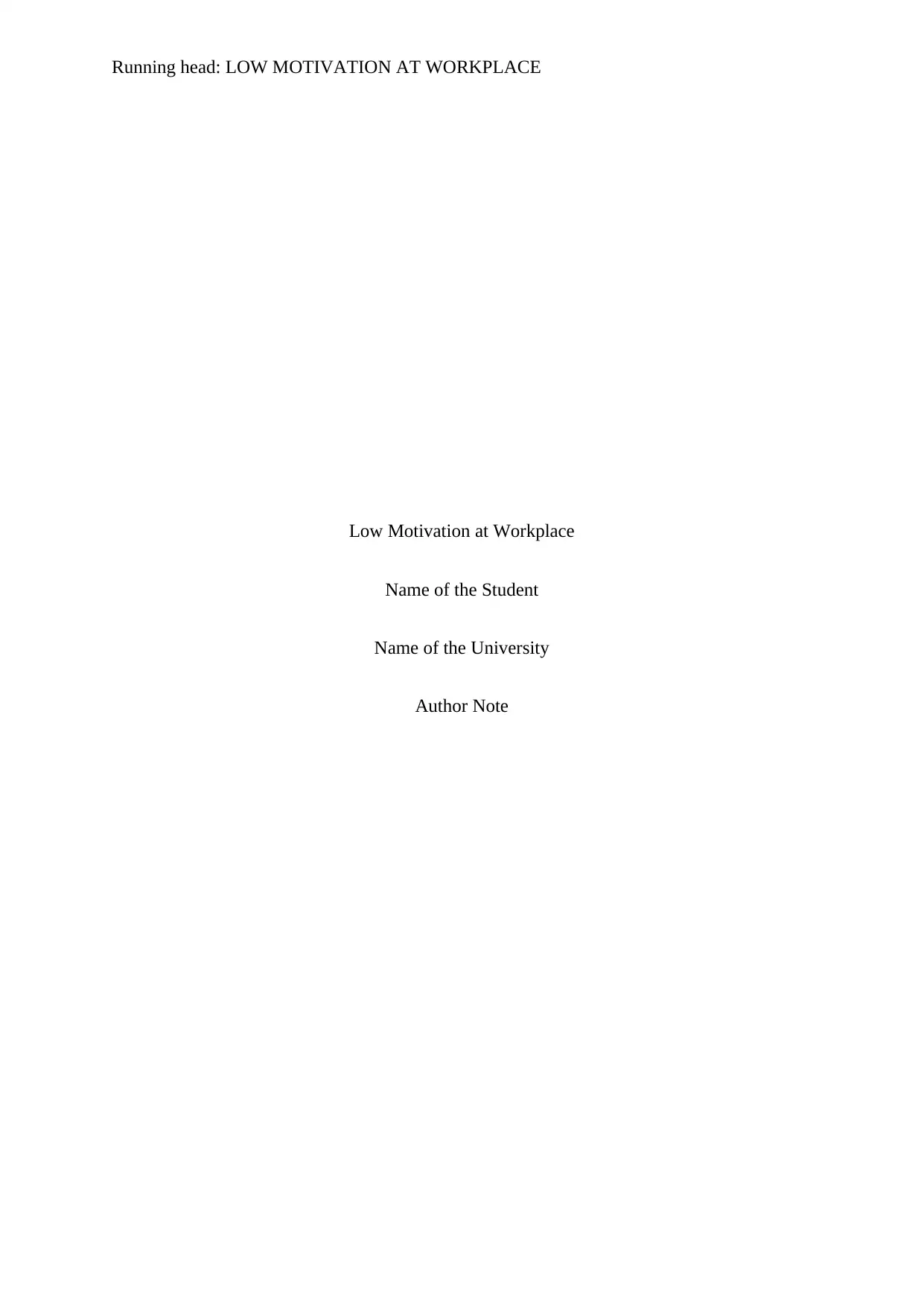
Running head: LOW MOTIVATION AT WORKPLACE
Low Motivation at Workplace
Name of the Student
Name of the University
Author Note
Low Motivation at Workplace
Name of the Student
Name of the University
Author Note
Paraphrase This Document
Need a fresh take? Get an instant paraphrase of this document with our AI Paraphraser
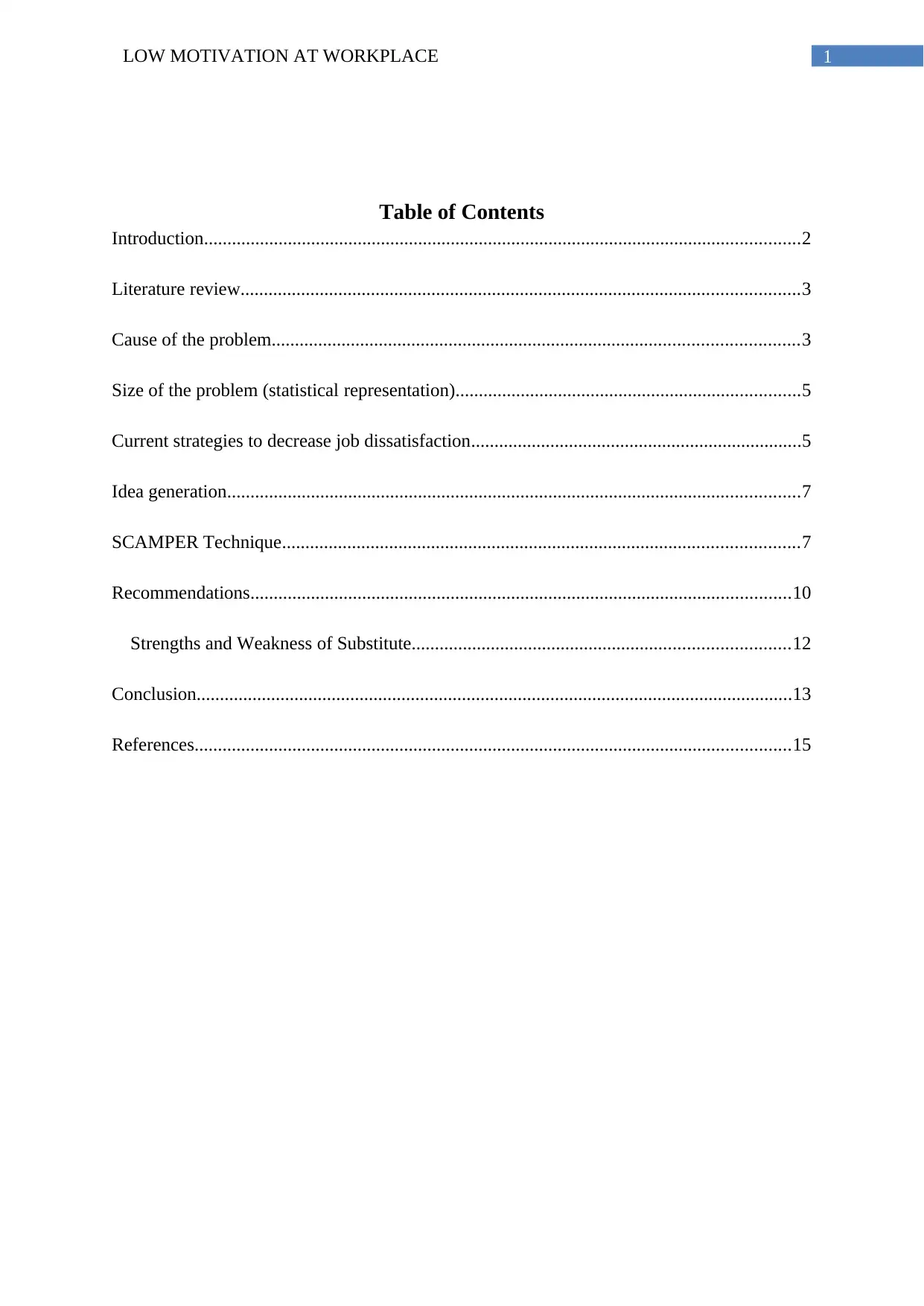
1LOW MOTIVATION AT WORKPLACE
Table of Contents
Introduction................................................................................................................................2
Literature review........................................................................................................................3
Cause of the problem.................................................................................................................3
Size of the problem (statistical representation)..........................................................................5
Current strategies to decrease job dissatisfaction.......................................................................5
Idea generation...........................................................................................................................7
SCAMPER Technique...............................................................................................................7
Recommendations....................................................................................................................10
Strengths and Weakness of Substitute.................................................................................12
Conclusion................................................................................................................................13
References................................................................................................................................15
Table of Contents
Introduction................................................................................................................................2
Literature review........................................................................................................................3
Cause of the problem.................................................................................................................3
Size of the problem (statistical representation)..........................................................................5
Current strategies to decrease job dissatisfaction.......................................................................5
Idea generation...........................................................................................................................7
SCAMPER Technique...............................................................................................................7
Recommendations....................................................................................................................10
Strengths and Weakness of Substitute.................................................................................12
Conclusion................................................................................................................................13
References................................................................................................................................15
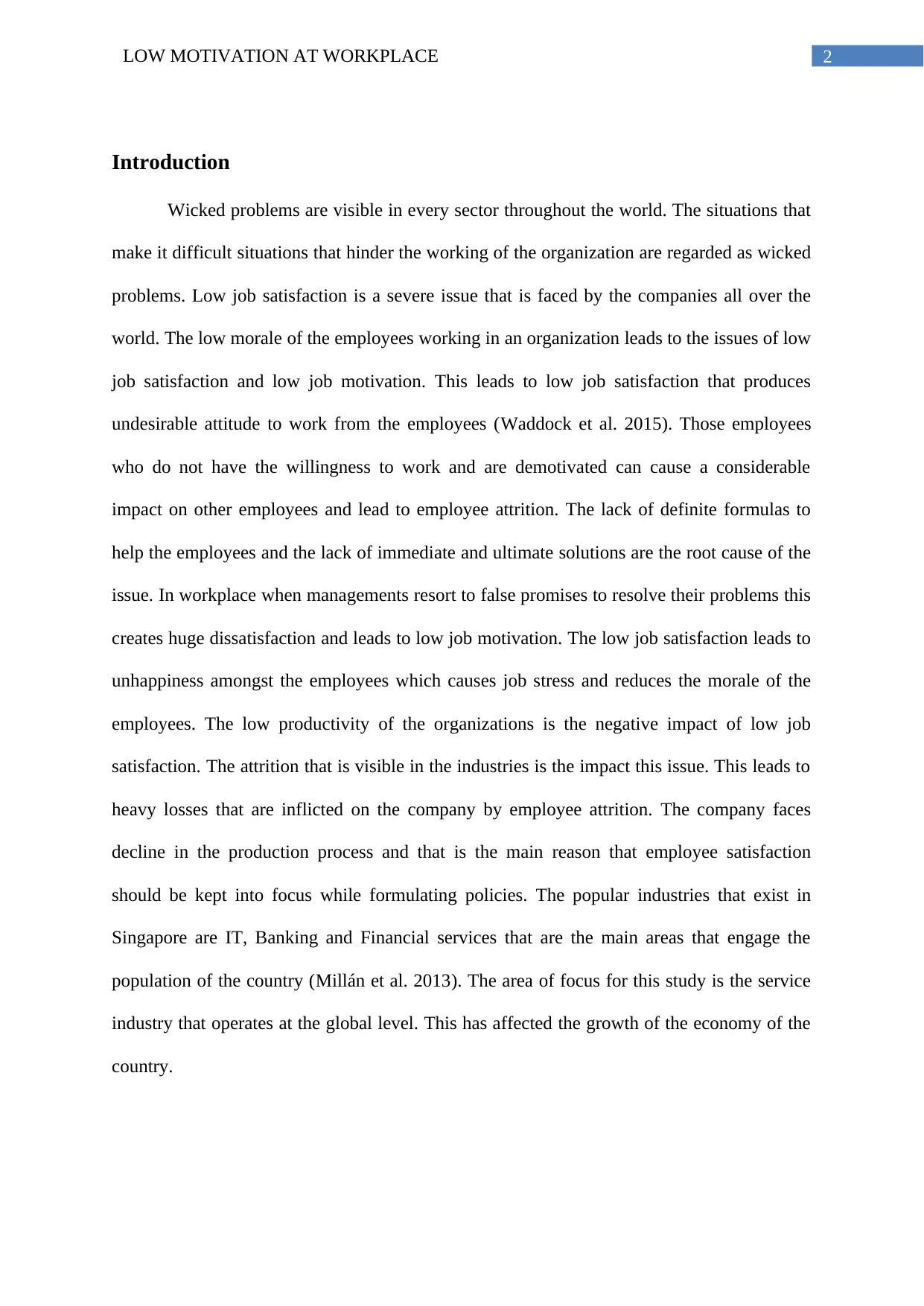
2LOW MOTIVATION AT WORKPLACE
Introduction
Wicked problems are visible in every sector throughout the world. The situations that
make it difficult situations that hinder the working of the organization are regarded as wicked
problems. Low job satisfaction is a severe issue that is faced by the companies all over the
world. The low morale of the employees working in an organization leads to the issues of low
job satisfaction and low job motivation. This leads to low job satisfaction that produces
undesirable attitude to work from the employees (Waddock et al. 2015). Those employees
who do not have the willingness to work and are demotivated can cause a considerable
impact on other employees and lead to employee attrition. The lack of definite formulas to
help the employees and the lack of immediate and ultimate solutions are the root cause of the
issue. In workplace when managements resort to false promises to resolve their problems this
creates huge dissatisfaction and leads to low job motivation. The low job satisfaction leads to
unhappiness amongst the employees which causes job stress and reduces the morale of the
employees. The low productivity of the organizations is the negative impact of low job
satisfaction. The attrition that is visible in the industries is the impact this issue. This leads to
heavy losses that are inflicted on the company by employee attrition. The company faces
decline in the production process and that is the main reason that employee satisfaction
should be kept into focus while formulating policies. The popular industries that exist in
Singapore are IT, Banking and Financial services that are the main areas that engage the
population of the country (Millán et al. 2013). The area of focus for this study is the service
industry that operates at the global level. This has affected the growth of the economy of the
country.
Introduction
Wicked problems are visible in every sector throughout the world. The situations that
make it difficult situations that hinder the working of the organization are regarded as wicked
problems. Low job satisfaction is a severe issue that is faced by the companies all over the
world. The low morale of the employees working in an organization leads to the issues of low
job satisfaction and low job motivation. This leads to low job satisfaction that produces
undesirable attitude to work from the employees (Waddock et al. 2015). Those employees
who do not have the willingness to work and are demotivated can cause a considerable
impact on other employees and lead to employee attrition. The lack of definite formulas to
help the employees and the lack of immediate and ultimate solutions are the root cause of the
issue. In workplace when managements resort to false promises to resolve their problems this
creates huge dissatisfaction and leads to low job motivation. The low job satisfaction leads to
unhappiness amongst the employees which causes job stress and reduces the morale of the
employees. The low productivity of the organizations is the negative impact of low job
satisfaction. The attrition that is visible in the industries is the impact this issue. This leads to
heavy losses that are inflicted on the company by employee attrition. The company faces
decline in the production process and that is the main reason that employee satisfaction
should be kept into focus while formulating policies. The popular industries that exist in
Singapore are IT, Banking and Financial services that are the main areas that engage the
population of the country (Millán et al. 2013). The area of focus for this study is the service
industry that operates at the global level. This has affected the growth of the economy of the
country.
⊘ This is a preview!⊘
Do you want full access?
Subscribe today to unlock all pages.

Trusted by 1+ million students worldwide
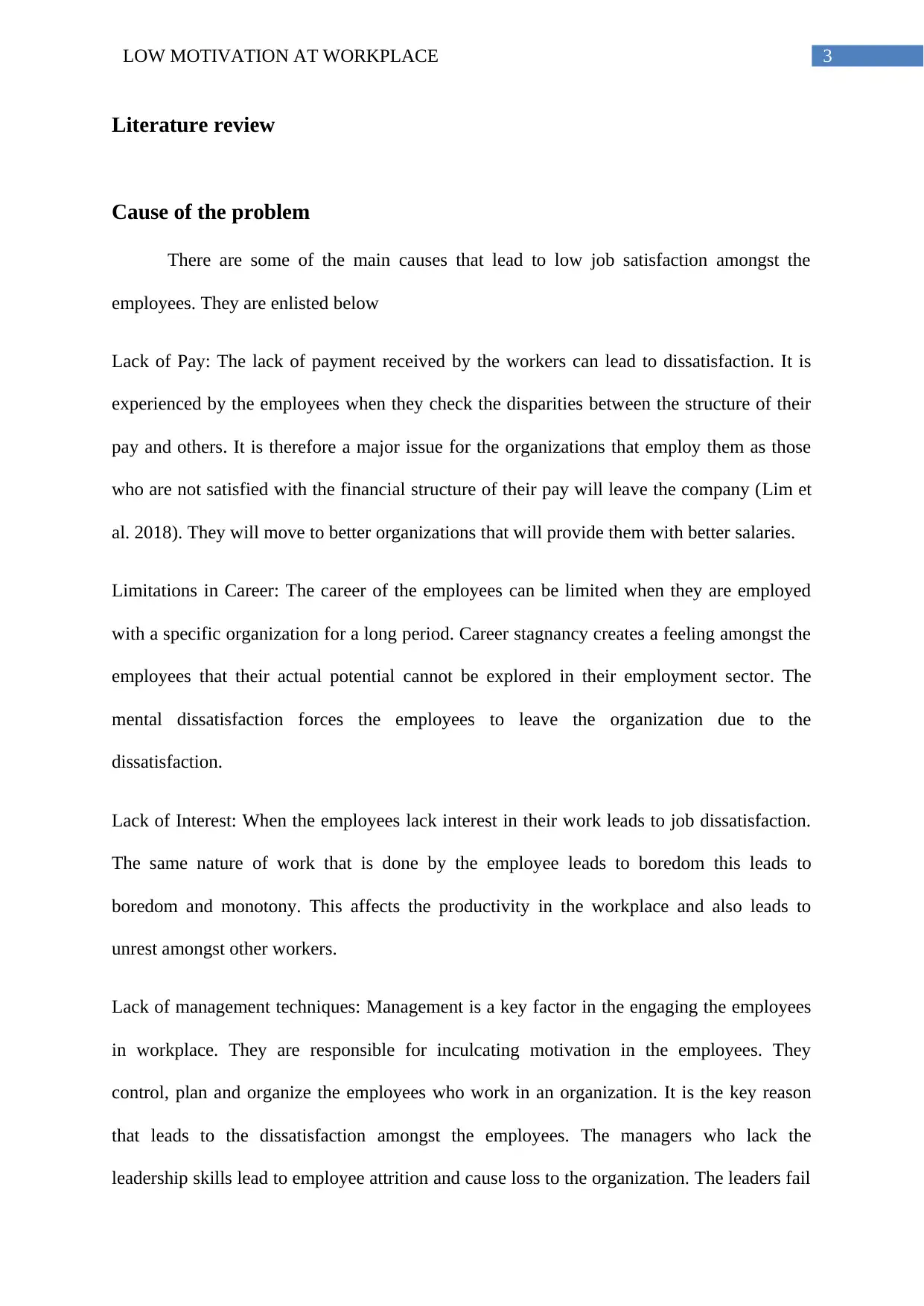
3LOW MOTIVATION AT WORKPLACE
Literature review
Cause of the problem
There are some of the main causes that lead to low job satisfaction amongst the
employees. They are enlisted below
Lack of Pay: The lack of payment received by the workers can lead to dissatisfaction. It is
experienced by the employees when they check the disparities between the structure of their
pay and others. It is therefore a major issue for the organizations that employ them as those
who are not satisfied with the financial structure of their pay will leave the company (Lim et
al. 2018). They will move to better organizations that will provide them with better salaries.
Limitations in Career: The career of the employees can be limited when they are employed
with a specific organization for a long period. Career stagnancy creates a feeling amongst the
employees that their actual potential cannot be explored in their employment sector. The
mental dissatisfaction forces the employees to leave the organization due to the
dissatisfaction.
Lack of Interest: When the employees lack interest in their work leads to job dissatisfaction.
The same nature of work that is done by the employee leads to boredom this leads to
boredom and monotony. This affects the productivity in the workplace and also leads to
unrest amongst other workers.
Lack of management techniques: Management is a key factor in the engaging the employees
in workplace. They are responsible for inculcating motivation in the employees. They
control, plan and organize the employees who work in an organization. It is the key reason
that leads to the dissatisfaction amongst the employees. The managers who lack the
leadership skills lead to employee attrition and cause loss to the organization. The leaders fail
Literature review
Cause of the problem
There are some of the main causes that lead to low job satisfaction amongst the
employees. They are enlisted below
Lack of Pay: The lack of payment received by the workers can lead to dissatisfaction. It is
experienced by the employees when they check the disparities between the structure of their
pay and others. It is therefore a major issue for the organizations that employ them as those
who are not satisfied with the financial structure of their pay will leave the company (Lim et
al. 2018). They will move to better organizations that will provide them with better salaries.
Limitations in Career: The career of the employees can be limited when they are employed
with a specific organization for a long period. Career stagnancy creates a feeling amongst the
employees that their actual potential cannot be explored in their employment sector. The
mental dissatisfaction forces the employees to leave the organization due to the
dissatisfaction.
Lack of Interest: When the employees lack interest in their work leads to job dissatisfaction.
The same nature of work that is done by the employee leads to boredom this leads to
boredom and monotony. This affects the productivity in the workplace and also leads to
unrest amongst other workers.
Lack of management techniques: Management is a key factor in the engaging the employees
in workplace. They are responsible for inculcating motivation in the employees. They
control, plan and organize the employees who work in an organization. It is the key reason
that leads to the dissatisfaction amongst the employees. The managers who lack the
leadership skills lead to employee attrition and cause loss to the organization. The leaders fail
Paraphrase This Document
Need a fresh take? Get an instant paraphrase of this document with our AI Paraphraser

4LOW MOTIVATION AT WORKPLACE
to motivate the employees that causes unrest within the organization. The opportunities are
reduced in the absence of effective leadership.
Unsupportive Higher Authority: The lack of support from the higher authorities in workplace
leads to heavily demotivate the employees. The disengagement from the authorities make
them misinformed about the happenings and sufferings of the employees. This creates an
environment of distrust among the employees and that leads to them quitting the organization
due to dissatisfaction.
Lack of growth in economy: One of the most important factor that motivates the employees is
economic gain. The lack of opportunities to develop a sustainable economy leads to
dissatisfaction. The meagre salary and the lack of incentives leads to this problem. The lack
of recognition from the authorities for the contributions makes the employees doubt their own
capability. This is the prime reason that leads to job dissatisfaction.
Lack of Balance in Personal and Professional Life: The pressure that an organization puts on
the employees leads them to work for longer hours. The work for longer hours consumes the
time the employees need to envisage to their families. This causes emotional unrest and
physical fatigue amongst them that affects the productivity. The lack of production leads to
dissatisfaction due to the failure to perform according to their own abilities.
to motivate the employees that causes unrest within the organization. The opportunities are
reduced in the absence of effective leadership.
Unsupportive Higher Authority: The lack of support from the higher authorities in workplace
leads to heavily demotivate the employees. The disengagement from the authorities make
them misinformed about the happenings and sufferings of the employees. This creates an
environment of distrust among the employees and that leads to them quitting the organization
due to dissatisfaction.
Lack of growth in economy: One of the most important factor that motivates the employees is
economic gain. The lack of opportunities to develop a sustainable economy leads to
dissatisfaction. The meagre salary and the lack of incentives leads to this problem. The lack
of recognition from the authorities for the contributions makes the employees doubt their own
capability. This is the prime reason that leads to job dissatisfaction.
Lack of Balance in Personal and Professional Life: The pressure that an organization puts on
the employees leads them to work for longer hours. The work for longer hours consumes the
time the employees need to envisage to their families. This causes emotional unrest and
physical fatigue amongst them that affects the productivity. The lack of production leads to
dissatisfaction due to the failure to perform according to their own abilities.

5LOW MOTIVATION AT WORKPLACE
Size of the problem (statistical representation)
This image will help to understand the disparities in the wages that are provided in service
industry.
Current strategies to decrease job dissatisfaction
Recognition of good work: Recognition is the best technique that can be used to
motivate the employees. The managers need to be aware about the achievements of the
workers. It was shown in the statistical data that 63% of the employees fail to receive
recognition that leads to job dissatisfaction (Rosen et al. 2017). Emotional intelligence
increases that the awareness about the performance of the team that leads to recognition. The
techniques for appreciating the employees are providing increments at regular intervals
(Balouch and Hassan 2014). Recognition should be provided at the public level that will help
in decreasing job dissatisfaction.
Size of the problem (statistical representation)
This image will help to understand the disparities in the wages that are provided in service
industry.
Current strategies to decrease job dissatisfaction
Recognition of good work: Recognition is the best technique that can be used to
motivate the employees. The managers need to be aware about the achievements of the
workers. It was shown in the statistical data that 63% of the employees fail to receive
recognition that leads to job dissatisfaction (Rosen et al. 2017). Emotional intelligence
increases that the awareness about the performance of the team that leads to recognition. The
techniques for appreciating the employees are providing increments at regular intervals
(Balouch and Hassan 2014). Recognition should be provided at the public level that will help
in decreasing job dissatisfaction.
⊘ This is a preview!⊘
Do you want full access?
Subscribe today to unlock all pages.

Trusted by 1+ million students worldwide

6LOW MOTIVATION AT WORKPLACE
Long term thinking: The thinking process should be focused to maintain satisfaction
amongst the employees. The short term thinking patterns lead to conflict amongst the
employees and that creates frustration amongst them. Therefore to keep the employees
engaged it is the duty of the leaders and people in authority to adhere to the needs of the
employees. The visionary attitude possessed by higher authorities can lead to highly
motivated employees (Gerhart and Fang 2015). This is highly a motivating factor as it shows
that the leaders are concerned about the future of the employees.
Effective communication: Communication can help to bridge the gap between the
employers and the workers. It is an effective process that helps to motivate the employees as
the lack of it can lead to miscommunication that is the root cause of misunderstanding. When
problems are not conveyed properly they will create disruption in workplace. Work culture
should be helpful for both the employee and the employers (Malik, Butt and Choi 2015).
Being in a comfortable to convey the issues faced by the employees will help the leaders to
find solution for the issues experienced.
Caring for the welfare of the employees: To show the employees that the authorities
are concerned about the welfare of the workers increases job satisfaction. The welfare of the
employees consist of two factors: physical and psychological wellbeing (Dugguh and Dennis
2014). The psychological wellbeing of the workers is important to inculcate a sense of calm
environment in workplace. To remove stress and anxiety from the mind of the workers can
cause psychological wellness. To work in a team can help to inculcate flexible attitude that
shows the psychological wellbeing. The trust they develop in their team members and the
higher authorities shows that the psychology of the workers has developed well. Whereas the
physical wellbeing of the can bring important changes in the process of production. The
efficiency in the process of production helps to promote job satisfaction amongst the workers.
Long term thinking: The thinking process should be focused to maintain satisfaction
amongst the employees. The short term thinking patterns lead to conflict amongst the
employees and that creates frustration amongst them. Therefore to keep the employees
engaged it is the duty of the leaders and people in authority to adhere to the needs of the
employees. The visionary attitude possessed by higher authorities can lead to highly
motivated employees (Gerhart and Fang 2015). This is highly a motivating factor as it shows
that the leaders are concerned about the future of the employees.
Effective communication: Communication can help to bridge the gap between the
employers and the workers. It is an effective process that helps to motivate the employees as
the lack of it can lead to miscommunication that is the root cause of misunderstanding. When
problems are not conveyed properly they will create disruption in workplace. Work culture
should be helpful for both the employee and the employers (Malik, Butt and Choi 2015).
Being in a comfortable to convey the issues faced by the employees will help the leaders to
find solution for the issues experienced.
Caring for the welfare of the employees: To show the employees that the authorities
are concerned about the welfare of the workers increases job satisfaction. The welfare of the
employees consist of two factors: physical and psychological wellbeing (Dugguh and Dennis
2014). The psychological wellbeing of the workers is important to inculcate a sense of calm
environment in workplace. To remove stress and anxiety from the mind of the workers can
cause psychological wellness. To work in a team can help to inculcate flexible attitude that
shows the psychological wellbeing. The trust they develop in their team members and the
higher authorities shows that the psychology of the workers has developed well. Whereas the
physical wellbeing of the can bring important changes in the process of production. The
efficiency in the process of production helps to promote job satisfaction amongst the workers.
Paraphrase This Document
Need a fresh take? Get an instant paraphrase of this document with our AI Paraphraser
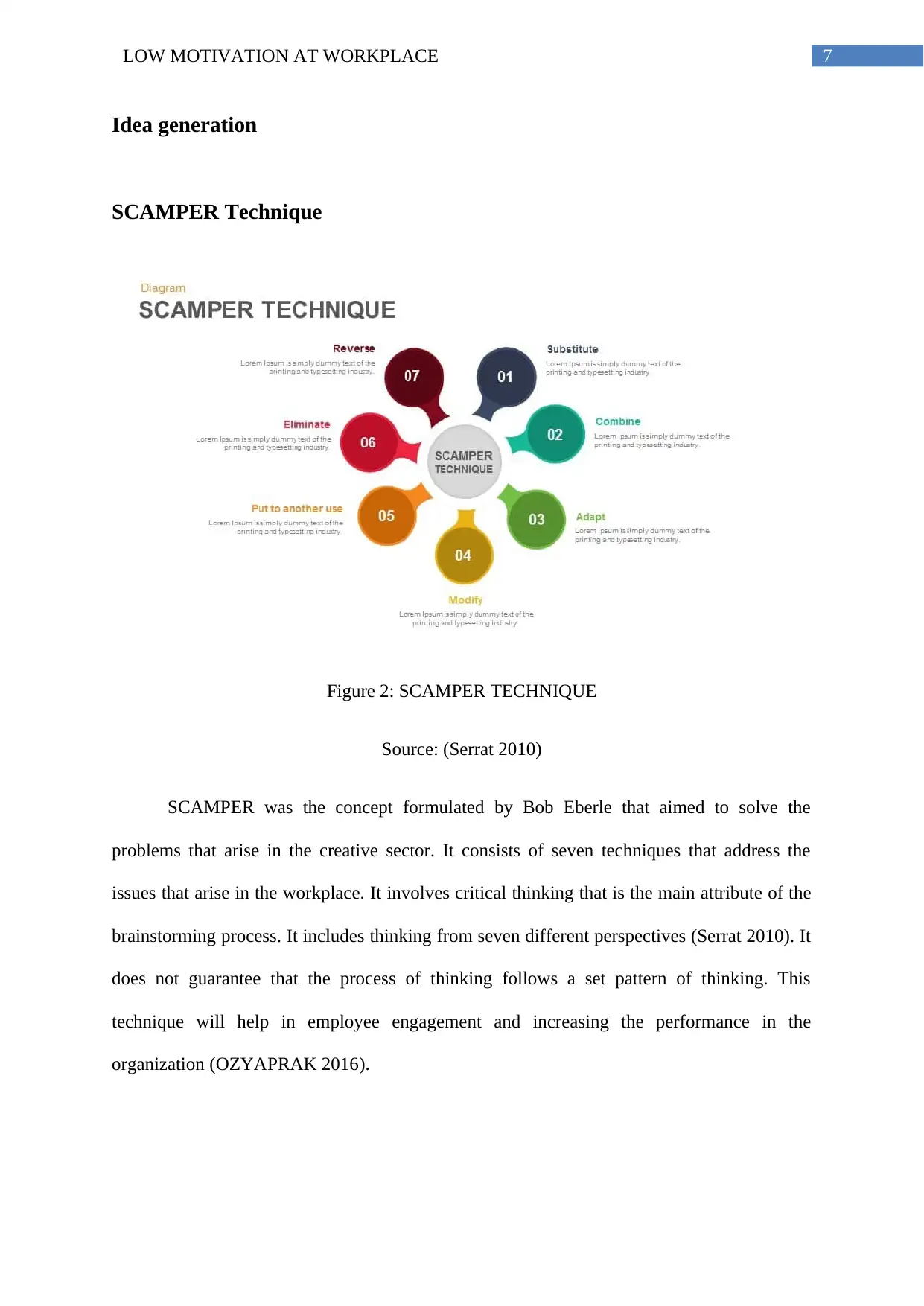
7LOW MOTIVATION AT WORKPLACE
Idea generation
SCAMPER Technique
Figure 2: SCAMPER TECHNIQUE
Source: (Serrat 2010)
SCAMPER was the concept formulated by Bob Eberle that aimed to solve the
problems that arise in the creative sector. It consists of seven techniques that address the
issues that arise in the workplace. It involves critical thinking that is the main attribute of the
brainstorming process. It includes thinking from seven different perspectives (Serrat 2010). It
does not guarantee that the process of thinking follows a set pattern of thinking. This
technique will help in employee engagement and increasing the performance in the
organization (OZYAPRAK 2016).
Idea generation
SCAMPER Technique
Figure 2: SCAMPER TECHNIQUE
Source: (Serrat 2010)
SCAMPER was the concept formulated by Bob Eberle that aimed to solve the
problems that arise in the creative sector. It consists of seven techniques that address the
issues that arise in the workplace. It involves critical thinking that is the main attribute of the
brainstorming process. It includes thinking from seven different perspectives (Serrat 2010). It
does not guarantee that the process of thinking follows a set pattern of thinking. This
technique will help in employee engagement and increasing the performance in the
organization (OZYAPRAK 2016).

8LOW MOTIVATION AT WORKPLACE
Substitute The traditional techniques of rewarding the
employees should be substituted with new
techniques that will help the organization to
retain the employees. The employees in the
organization always strive to attain better
rewards. Therefore, it is the responsibility of
the leaders and the organization to
financially reward the employees that will
lead to better performance and job
satisfaction.
Combine The communication process and the goals of
the employer and the employees should be
combined that will help to decrease the job
dissatisfaction. The effective
communication will help to convey the
ideas properly to the management
authorities. This will help in increasing job
satisfaction.
Adapt The employees should adapt their skills
according to the need of the times. The
development of skills will lead to new
opportunities. The new opportunities will
help in decreasing the feeling of monotony
that they experience and lead to the
Substitute The traditional techniques of rewarding the
employees should be substituted with new
techniques that will help the organization to
retain the employees. The employees in the
organization always strive to attain better
rewards. Therefore, it is the responsibility of
the leaders and the organization to
financially reward the employees that will
lead to better performance and job
satisfaction.
Combine The communication process and the goals of
the employer and the employees should be
combined that will help to decrease the job
dissatisfaction. The effective
communication will help to convey the
ideas properly to the management
authorities. This will help in increasing job
satisfaction.
Adapt The employees should adapt their skills
according to the need of the times. The
development of skills will lead to new
opportunities. The new opportunities will
help in decreasing the feeling of monotony
that they experience and lead to the
⊘ This is a preview!⊘
Do you want full access?
Subscribe today to unlock all pages.

Trusted by 1+ million students worldwide

9LOW MOTIVATION AT WORKPLACE
retention of the employees. The retention of
the employees will lead to better
performance of the companies. The better
performance yields benefits for both the
employee and the employers.
Modify The existing policies in the workplace that
result in the loss of employees cab be
modified according to the need of the
employees. The adherence to the will of the
employees will create trust in them
regarding the organization and help in
creating satisfaction.
Put another to use The existing policies regarding the
employment should be put into use to help
the employees secure their future in the
organization. The existing policies need to
be employee friendly that will help to
enhance the employee engagement.
Eliminate The existing rigid policies should be
eliminated that result in the loss of
employees (Lim, Yusof and Ismail 2018).
The recognition and rewarding techniques
should be enacted by the management
helping them to retain a large number of
employees.
retention of the employees. The retention of
the employees will lead to better
performance of the companies. The better
performance yields benefits for both the
employee and the employers.
Modify The existing policies in the workplace that
result in the loss of employees cab be
modified according to the need of the
employees. The adherence to the will of the
employees will create trust in them
regarding the organization and help in
creating satisfaction.
Put another to use The existing policies regarding the
employment should be put into use to help
the employees secure their future in the
organization. The existing policies need to
be employee friendly that will help to
enhance the employee engagement.
Eliminate The existing rigid policies should be
eliminated that result in the loss of
employees (Lim, Yusof and Ismail 2018).
The recognition and rewarding techniques
should be enacted by the management
helping them to retain a large number of
employees.
Paraphrase This Document
Need a fresh take? Get an instant paraphrase of this document with our AI Paraphraser
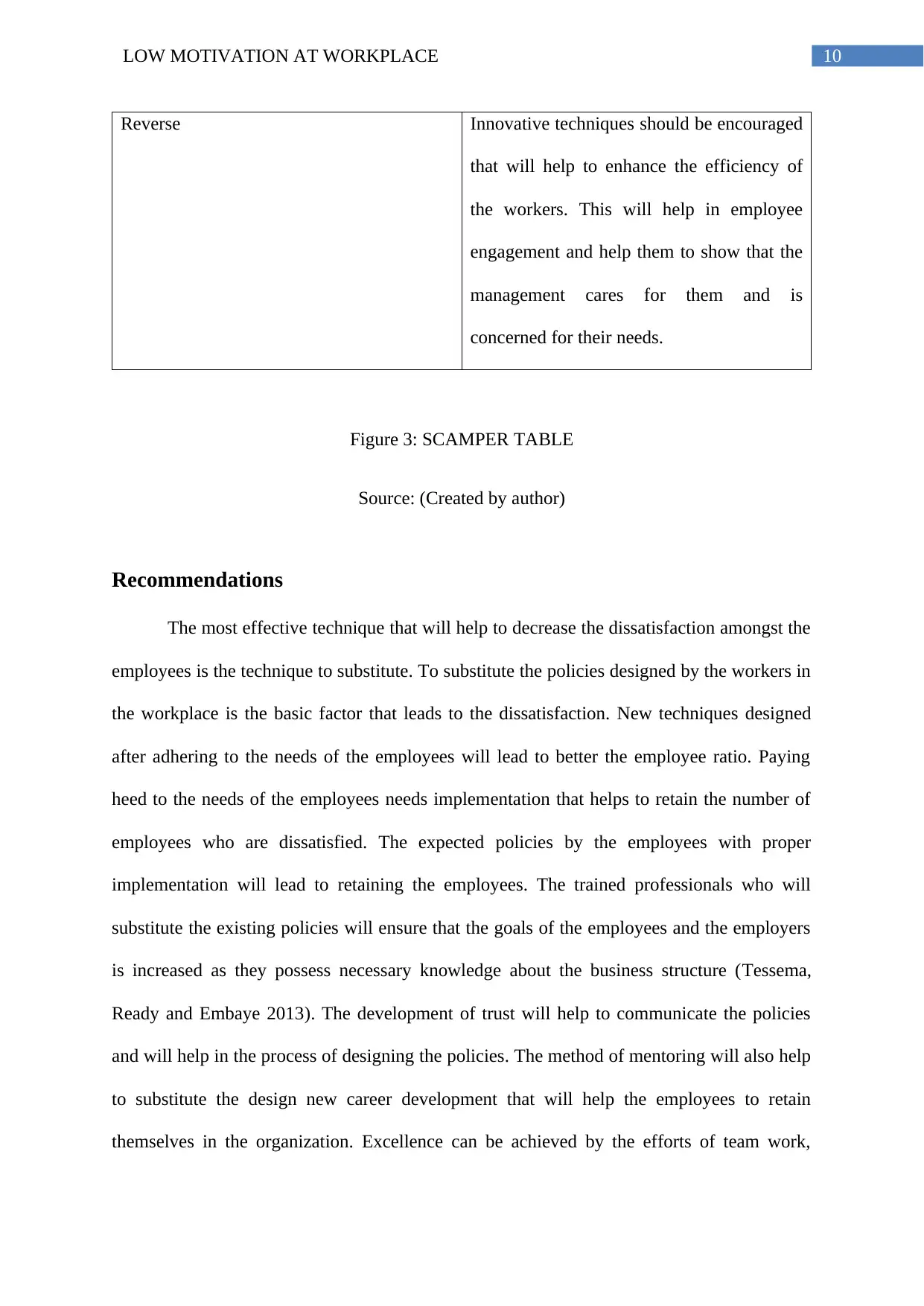
10LOW MOTIVATION AT WORKPLACE
Reverse Innovative techniques should be encouraged
that will help to enhance the efficiency of
the workers. This will help in employee
engagement and help them to show that the
management cares for them and is
concerned for their needs.
Figure 3: SCAMPER TABLE
Source: (Created by author)
Recommendations
The most effective technique that will help to decrease the dissatisfaction amongst the
employees is the technique to substitute. To substitute the policies designed by the workers in
the workplace is the basic factor that leads to the dissatisfaction. New techniques designed
after adhering to the needs of the employees will lead to better the employee ratio. Paying
heed to the needs of the employees needs implementation that helps to retain the number of
employees who are dissatisfied. The expected policies by the employees with proper
implementation will lead to retaining the employees. The trained professionals who will
substitute the existing policies will ensure that the goals of the employees and the employers
is increased as they possess necessary knowledge about the business structure (Tessema,
Ready and Embaye 2013). The development of trust will help to communicate the policies
and will help in the process of designing the policies. The method of mentoring will also help
to substitute the design new career development that will help the employees to retain
themselves in the organization. Excellence can be achieved by the efforts of team work,
Reverse Innovative techniques should be encouraged
that will help to enhance the efficiency of
the workers. This will help in employee
engagement and help them to show that the
management cares for them and is
concerned for their needs.
Figure 3: SCAMPER TABLE
Source: (Created by author)
Recommendations
The most effective technique that will help to decrease the dissatisfaction amongst the
employees is the technique to substitute. To substitute the policies designed by the workers in
the workplace is the basic factor that leads to the dissatisfaction. New techniques designed
after adhering to the needs of the employees will lead to better the employee ratio. Paying
heed to the needs of the employees needs implementation that helps to retain the number of
employees who are dissatisfied. The expected policies by the employees with proper
implementation will lead to retaining the employees. The trained professionals who will
substitute the existing policies will ensure that the goals of the employees and the employers
is increased as they possess necessary knowledge about the business structure (Tessema,
Ready and Embaye 2013). The development of trust will help to communicate the policies
and will help in the process of designing the policies. The method of mentoring will also help
to substitute the design new career development that will help the employees to retain
themselves in the organization. Excellence can be achieved by the efforts of team work,
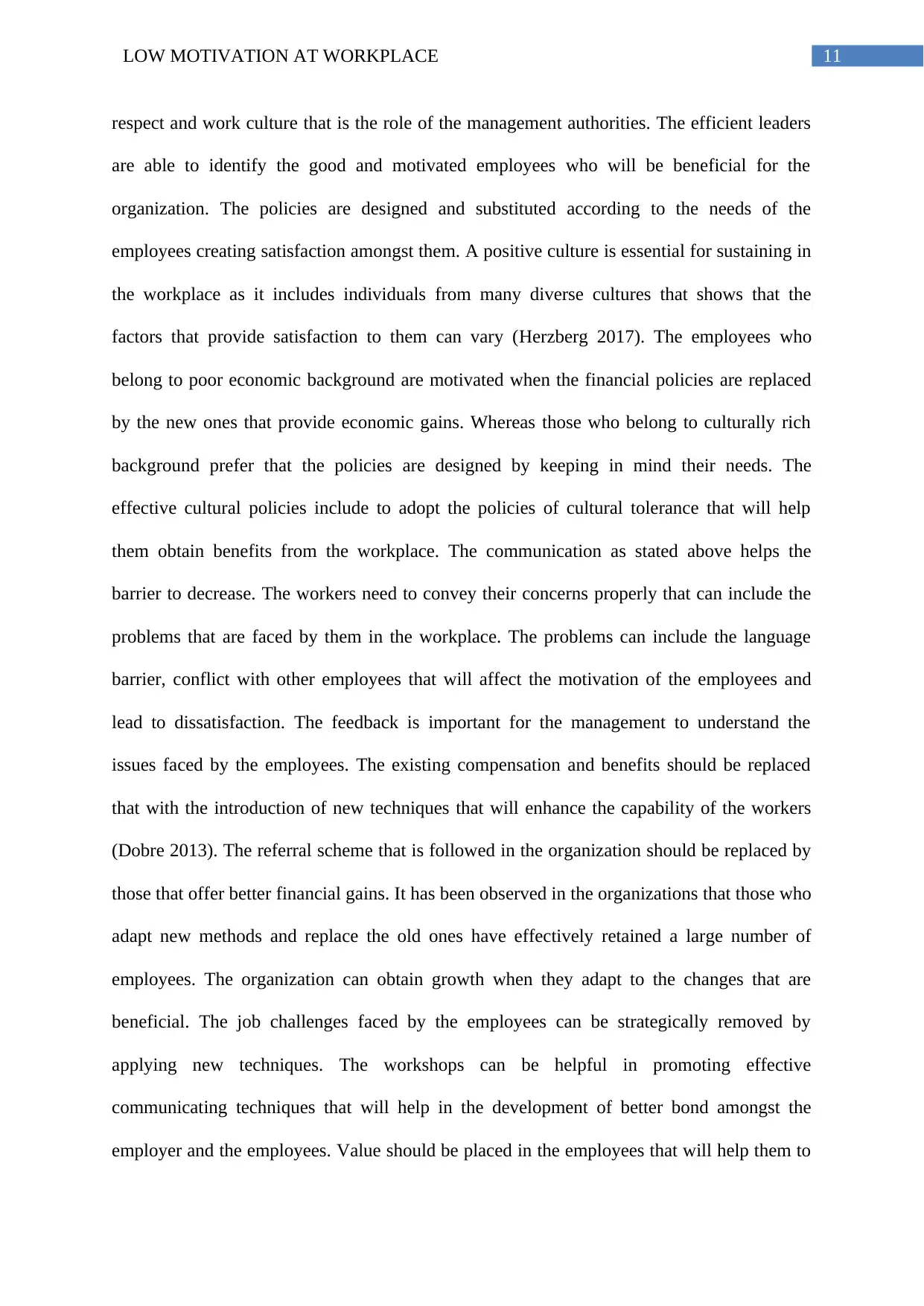
11LOW MOTIVATION AT WORKPLACE
respect and work culture that is the role of the management authorities. The efficient leaders
are able to identify the good and motivated employees who will be beneficial for the
organization. The policies are designed and substituted according to the needs of the
employees creating satisfaction amongst them. A positive culture is essential for sustaining in
the workplace as it includes individuals from many diverse cultures that shows that the
factors that provide satisfaction to them can vary (Herzberg 2017). The employees who
belong to poor economic background are motivated when the financial policies are replaced
by the new ones that provide economic gains. Whereas those who belong to culturally rich
background prefer that the policies are designed by keeping in mind their needs. The
effective cultural policies include to adopt the policies of cultural tolerance that will help
them obtain benefits from the workplace. The communication as stated above helps the
barrier to decrease. The workers need to convey their concerns properly that can include the
problems that are faced by them in the workplace. The problems can include the language
barrier, conflict with other employees that will affect the motivation of the employees and
lead to dissatisfaction. The feedback is important for the management to understand the
issues faced by the employees. The existing compensation and benefits should be replaced
that with the introduction of new techniques that will enhance the capability of the workers
(Dobre 2013). The referral scheme that is followed in the organization should be replaced by
those that offer better financial gains. It has been observed in the organizations that those who
adapt new methods and replace the old ones have effectively retained a large number of
employees. The organization can obtain growth when they adapt to the changes that are
beneficial. The job challenges faced by the employees can be strategically removed by
applying new techniques. The workshops can be helpful in promoting effective
communicating techniques that will help in the development of better bond amongst the
employer and the employees. Value should be placed in the employees that will help them to
respect and work culture that is the role of the management authorities. The efficient leaders
are able to identify the good and motivated employees who will be beneficial for the
organization. The policies are designed and substituted according to the needs of the
employees creating satisfaction amongst them. A positive culture is essential for sustaining in
the workplace as it includes individuals from many diverse cultures that shows that the
factors that provide satisfaction to them can vary (Herzberg 2017). The employees who
belong to poor economic background are motivated when the financial policies are replaced
by the new ones that provide economic gains. Whereas those who belong to culturally rich
background prefer that the policies are designed by keeping in mind their needs. The
effective cultural policies include to adopt the policies of cultural tolerance that will help
them obtain benefits from the workplace. The communication as stated above helps the
barrier to decrease. The workers need to convey their concerns properly that can include the
problems that are faced by them in the workplace. The problems can include the language
barrier, conflict with other employees that will affect the motivation of the employees and
lead to dissatisfaction. The feedback is important for the management to understand the
issues faced by the employees. The existing compensation and benefits should be replaced
that with the introduction of new techniques that will enhance the capability of the workers
(Dobre 2013). The referral scheme that is followed in the organization should be replaced by
those that offer better financial gains. It has been observed in the organizations that those who
adapt new methods and replace the old ones have effectively retained a large number of
employees. The organization can obtain growth when they adapt to the changes that are
beneficial. The job challenges faced by the employees can be strategically removed by
applying new techniques. The workshops can be helpful in promoting effective
communicating techniques that will help in the development of better bond amongst the
employer and the employees. Value should be placed in the employees that will help them to
⊘ This is a preview!⊘
Do you want full access?
Subscribe today to unlock all pages.

Trusted by 1+ million students worldwide
1 out of 18
Related Documents
Your All-in-One AI-Powered Toolkit for Academic Success.
+13062052269
info@desklib.com
Available 24*7 on WhatsApp / Email
![[object Object]](/_next/static/media/star-bottom.7253800d.svg)
Unlock your academic potential
Copyright © 2020–2025 A2Z Services. All Rights Reserved. Developed and managed by ZUCOL.





